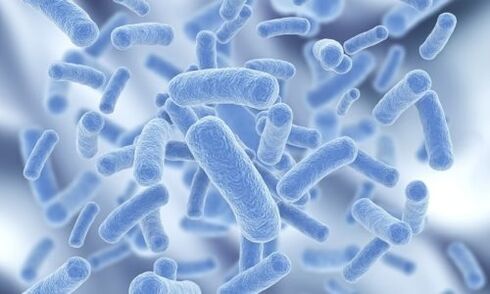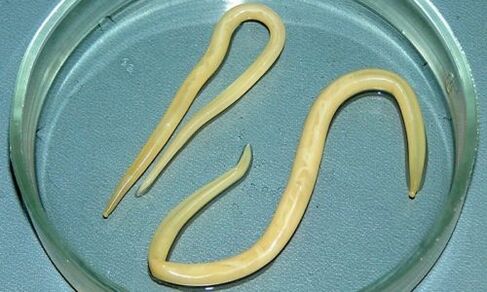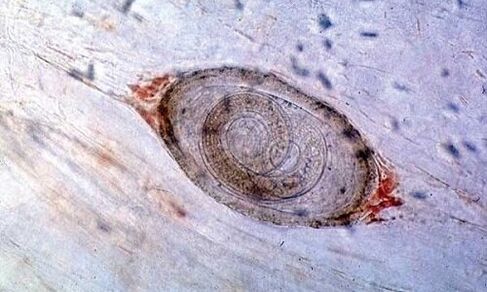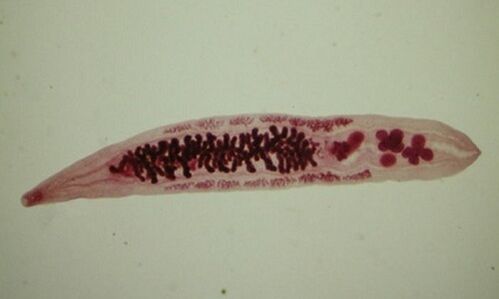It is customary to call human parasites all organisms living at their expense. These are bacteria, fungus, worms. Human parasites are divided into internal and external. The most unpleasant and causing the greatest amount of destruction of the body are helminths - a variety of parasitic worms.

Parasites and the human body
The creatures parasitizing on the human body can be external or internal. External include:
- Mosquitoes.
- Leeches.
- Lice.
- Microorganisms that cause scabies.
But there are much more creatures who prefer to settle inside the body. These include:
- Bacteria.
- The simplest.
- Helminths.
- Fungal.
The external and internal organization of the parasite belongs to the simplest. Due to the fact that they do not need to evolve for survival, their organization is greatly simplified.

There are a lot of creatures who prefer to settle inside the body. For example, it can be bacteria.
They cannot survive without a host organism, as they are unable to obtain their own food. But they all breed, almost without exception, very quickly, especially in suitable conditions. Where they are not immediately driven.
They differ geographically. Some can be found everywhere, no climate is a hindrance for them. Others live exclusively in tropical countries, but on the human body they can easily be brought to any others. In the body, they also settle in different places.
The luminal parasites are satisfied with the hollow parts of the body, and the tissue ones live in the tissues.
The cycles of development of parasites, mainly helminths, are also varied. Some first develop in the ground (biohelminths), and then move to a living creature. Others need to first develop in the body of any other living creature, but not a person. Still others in an already adult state can be transferred to another or re-infect oneself.
It is a mistake to assume that infection can occur exclusively through dirty hands. The eggs of some helminths are viable outside the nutrient medium for six months and adhere perfectly to animal hair. Eggs also survive in a dangerous environment for them - if you cook meat or fish incorrectly, a whole brood of worms can settle inside you.

It is worth cooking the meat incorrectly, as a whole brood of worms can settle inside you.
Human endoparasites
Parasites are divided into endoparasites and ectoparasites. Endoparasites - those that live inside, ecto - outside. Endoparasites are capable of settling in almost all internal organs and tissues of the body. Separate them depending on the location. Endoparasites are:
- Endoparasites of internal organs connecting with the external environment.
They settle precisely in those organs that are connected with the external environment, not vice versa: the parasitic organism does not choose to "breathe". These organs include the intestines, lungs, and the human urinary-reproductive system. These are amoebas, worms and parasitic flagellates.
- Blood parasites.
They live in human blood. They can live in plasma, white blood cells, erythrocytes. These are trypanosomes, microfilariae or hemosporidia.
- Tissue endoparasites.
Those endoparasites that choose the tissues of the body as their place of residence. Muscle tissue, brain, cartilage, connective tissue. Even in nerve fibers, tissue endoparasitis can settle. These are Finnish tapeworms, trypanosomes, myxosporidia, trichina and others.

Endoparasites can choose the brain as their place of residence.
The definition of the type of parasite by the place of its localization is rather arbitrary. Many species are able to migrate through various internal organs and regularly travel through the host's body. The reproduction process can take place in one place, and organisms will directly exist and feed in another. The place where the parasitic creature settles down and will be considered the place of its conditional localization.
Despite the simplification of many parasite systems, their life cycle is quite complex.
Some species throughout their life have to change several hosts, which may belong to different biological species. Others are able to survive within only one species, but they may require intermediate hosts. In one person they multiply, and in another they develop and mature. With such a complex life cycle, their sexual functions are significantly increased. To survive in the body, parasites have to multiply quickly and a lot.
Helminths
There are three main types of helminths, also called worms. It:
- Nematodes, they are roundworms.
- Cestodes, tape-shaped endoparasites.
- Trematodes, also known as flukes.

Geohelminths begin their existence in the earth's soil.
Further, they can be divided according to the duration of the life cycle and the number of locations that they pass along the way. There are also three types:
Geohelminths
"Geo" is the earth. These worms begin their existence in the earth's soil, only after the stage of maturation are they able to infect a person. They do not need intermediate hosts; eggs enter the soil together with human feces. Until the larval stage, they develop exclusively in the warm season.
Such worms include roundworms, intestinal eels, nekator, whipworms.
The larvae of these parasites can enter the human body through unwashed vegetables or direct contact with the soil.
Biohelminths
These are parasitic worms whose life stages pass through several hosts. There can be two or more intermediate hosts, depending on the type of worm. Some parasites change only a person. Others, before finally getting into the human body, use the organisms of other biological beings for development.

You can become infected through pets or through contact with other people, as well as by eating half-raw meat. Biohelminths include bovine tapeworms, echinococcus, broad tapeworm, trichina and others.
Contagious worms
These worms need neither soil nor intermediate hosts. They go through all the stages of their life cycle in one organism, very comfortably located. The larvae are excreted directly from the human body, spreading freely upon contact with household surfaces and other people.
Helminths can live in different organs and systems of the human body, periodically migrating from one part of the body to another.
The list of diseases that are caused by helminths is very extensive. It is possible to determine which parasites live in the body and which treatment can be started only after all the tests necessary to establish the type of tests have been passed.
Round worms
The most widespread in the human environment are roundworms, also known as nematodes. In total, there are more than 24 thousand species of nematodes in the world.

The most common human nematodes are roundworms.
They are called round because of their shape, which is revealed if you make a cross section. The most common human nematodes:
- Ascaris.
- Pinworms.
- Trichina.
- Vlasoglava.
The helminthic infestation, known as ascariasis, begins with direct contact with worm-infested soil or by eating unwashed fruits and vegetables. Parasites begin to develop in the intestines, then enter the human circulatory system, from where they go to various internal organs, heading to the oral cavity. A person, without noticing this, re-swallows an already adult parasite. They feed on the remains of undigested food. Ascaris waste products are extremely toxic. There is no vaccine for ascariasis; infection can be prevented only by observing the rules of personal hygiene.
Pinworm infection is called enterobiasis. These are small worms (5-10 mm) that attach to the intestinal walls. They feed on blood and intestinal contents. They lay their eggs under the skin, getting out of the anus while the owner sleeps. Because of the itching, a person scratches the anal area, the larvae get under the skin and on the hands, and can be easily transmitted to other people in the house or in public places. There are no painful symptoms in enterobiasis; it is extremely problematic to detect pinworm infection at the initial stage.
Trichinella, they are also Trichina, are roundworms that choose an animal or a person as their owner.

Trichinella is a parasitic worm that infects the human body, causing the dangerous helminthic disease trichinosis.
They begin to develop in the area of striated muscles in the body, then they are redirected to the small intestine. In advanced cases of infection, there can be about 15 thousand Trichina eggs per kilogram of muscle tissue. These parasites are capable of causing a deadly disease, named for its source - trichinosis.
The whipworms are so named because of their appearance. The anterior part of their little body is threadlike, with one esophagus located in it.
The back part is wider, the rest of the internal organs of the parasite are located in it. The whipworm can be up to 50 mm long. It feeds on blood and tissue fluid. Trichocephalosis causes the disease.
Tapeworms
There are about 3, 500 known tapeworm species around the world, also called cestodes. These flatworms have no digestive system at all, and the diseases they cause are called cestodoses.
The most common cestodoses:
Cysticercosis
The disease is caused by the larvae of the pork tapeworm, which get inside through contaminated food, from dirty hands.

The disease affects the skin, bones, internal organs, brain and spinal cord. Most often, parasites are sent to the brain (in 60% of infections). It is diagnosed based on the appearance of rounded formations on the skin. The disease is treated; in case of infection of the central nervous system, the prognosis may be unfavorable.
Echinococcosis
It is localized in the liver, lungs, and many other internal organs. Echinococcus larvae excite the disease. They can develop inside a person over the course of several years.
Infection occurs through contact with animals, picking berries and fruits, drinking contaminated water.
The course of the disease is not too noticeable, it can develop over the years, and it turns out to be detected only by chance.
Alveococcosis
Alveococcosis is caused by the larvae of alveococcus worms. The disease is similar to echinococcosis, but is more severe. Affects the lungs and kidneys. Without treatment, the disease is highly likely to be fatal due to the development of liver failure.

Alveococcosis most often affects the kidneys.
Teniarinhoz
Teniarinhoz is caused by a bovine tapeworm. It parasitizes tapeworm in the area of the human small intestine, develops over a period of 2. 5-4 months. The prognosis for treatment is often favorable. Parasites can get inside a person with infected raw or insufficiently thermally processed meat.
Tapeworms are highly prolific. They have the most reduced remaining sensitivity and no digestive system at all. Such parasites cannot develop without a host.
Fluke worms
Flukes are flukes. These are flat worms, in the shape of their body resembling an oblong leaf of a tree.
Some species of trematodes can be up to one and a half meters in size.
And they end up in the human body most often through fish or other seafood. About 7, 200 species of fluke are known, 40 of which inhabit humans and cause trematodes, a serious illness caused by infection.
The most common flukes:
Liver fluke
Globally distributed, can exist in animals and humans. The biological life cycle is complex, the parasite changes hosts.

The most common fluke is liver fluke.
Schistosoma
Schistosome larvae can penetrate the skin or mucous membranes. The life cycle is complex, they feed on blood. One female is capable of producing about 3000 eggs per day, the fertility of these parasitic worms is very high.
Other liver flukes
They cause opisthorchiasis, a helminthic disease that spreads mostly in the liver. They have a toxic effect on the human body.
The digestive system of fluke worms is well developed, and with it the reproductive and excretory system.
The rest of the systems are developing poorly. Trematodes feed on blood, epithelial cells of the skin, and intestinal contents. They can live almost anywhere: from the liver to the conjunctivial sacs of the eyes.
Other types of endoparasites
The rest of the internal parasites are a variety of bacteria that cause dangerous diseases, and with them the simplest microorganisms. The fungus that spreads inside the human body also belongs to the section of endoparasites.
Many beneficial and harmful microorganisms live in the human body. Some of them cause quite dangerous diseases that can lead to death. It is not always possible to immediately recognize the presence of parasitic creatures within oneself, but early diagnosis of infection gives a better chance of a complete cure. If an invasion is suspected, it is recommended to promptly undergo a full examination by a doctor.

































